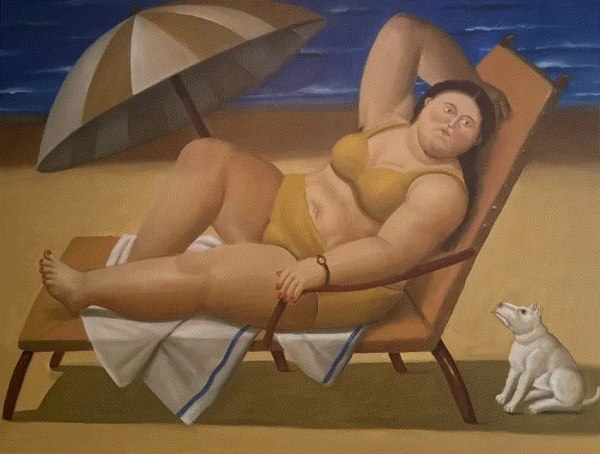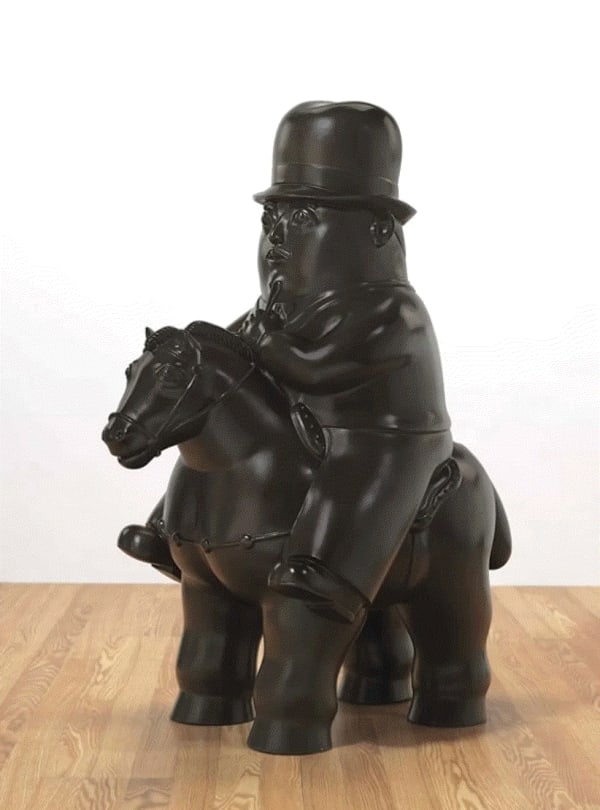Fernando Botero
I am not a slave to reality. I am a slave to art. – Fernando Botero
Fernando Botero remains one of South America’s most beloved artists. His unique style of painting and sculpting figures with exaggerated volume is known as Boterismo.
Botero was born in Medellin, Colombia on April 19, 1932, the second of three sons. His father was a traveling salesman, his mother a seamstress. Botero’s father died when he was just four, leaving behind a collection of illustrated books that were an early inspiration. After his primary school education, Botero received a scholarship at the Jesuit School of Bolívar.
Botero’s uncle stepped in as father figure and sent Botero to a school for matadors when he was twelve. During his two years at the school, Botero discovered that he was more interested in drawing the bulls and matadors than training to be a matador. A ticket seller helped Botero sell his sketches and watercolors of bulls and matadors. The artwork helped Botero to get his works shown in a group exhibit and published in one of the city’s leading newspapers.
In 1951, Botero had a solo exhibit. It was very successful and Botero was awarded second prize in Bogotá's Salón Nacional de Artistas. He spent the next four years traveling around Europe, visiting museums and drawing inspiration from the works of Goya, Velazquez and Early Renaissance masters.
It was in 1956, while in Mexico City with his first wife, Gloria Zea, that Botero found his style. While painting a mandolin, he enlarged the center hole of the instrument, which led him to play with its other proportions. The style was especially successful when he painted still lifes and figures.
In 1957 Botero had his first exhibit in the U.S., in Washington, D.C. It sold out. Botero returned to Columbia, and taught painting at the Bogotá Academy of Art.
Botero and Zea had three children together and divorced in 1960. Their son, Fernando, became Minister of Defense in Columbia.
Botero moved to New York, where he lived with Cecilia Zambrano. The couple had one son who, sadly, was killed in a car accident. Botero and Zambrano separated in 1975. It was in New York that he began to create sculptures and include to political satire, especially of the Columbian government, in his works.
In 1978, Botero married Greek painter and sculptor, Sophia Vari. The couple remained together until her death in May of 2023 at age 82.
Botero’s huge bronze sculptures can be seen in cities around the world, including New York, Paris and Barcelona.
His work was not without controversy. Botero was the victim of a failed kidnapping in Bogota in 1994. The following year, while Fernando was Minister of Defense, a terrorist group detonated 22 pounds of dynamite under a sculpture that Botero had donated to the city. Thirty people were killed, about two hundred wounded. The group claimed that the bomb was in retaliation for Fernando’s refusal to enter into political negotiations with them. Botero created a new statue, with the victims' names engraved in the base.
Botero and Vari spent the final years of their life together in Paris and Monte Carlo Botero died from complications of pneumonia on September 15, 2023, at age 91, in Monaco, just four months after Vari’s death.
Send me more information on Fernando Botero
-

The Works of Fernando Botero Travel to China
Alex Katz Celebrated His 98th Birthday August 28, 2025The works of Fernando Botero have been garnering increased global attention and his auction sales have more than doubled since 2020. Botero was born in...Read more -

The Increased Appreciation of the Work of Fernando Botero
March 20, 2025Art is always an exaggeration in some sense; in color, in form, even in theme, etc…but it has always been this way. - Fernando Botero...Read more -

Sculptures by Fernando Botero, Frank Stella and Robert Indiana at Miami Sculpture Garden
December 19, 2024The works of more than fifty major artists have been installed at the Nader Sculpture Garden, in Miami’s Design District, opened to the public during...Read more -

Works by Fernando Botero at Surovek Gallery
Paper and Light: Masterworks on Paper November 1, 2024My popularity has to do with the divorce between modern art, where everything is obscure, and the viewer who often feels he needs a professor...Read more -

Fernando Botero and Elie Nadelman Sculptures at Surovek Gallery
February 9, 2024Fernando Botero’s (1932-2023) voluminous paintings and sculptures made him South America’s best known and beloved artist. His works are sensual, joyful. Many are filled with...Read more










